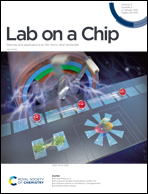Flow shear stress controls the initiation of neovascularization via heparan sulfate proteoglycans within a biomimetic microfluidic model†
Abstract
Endothelial cells (ECs) in vivo are subjected to three forms of shear stress induced by luminal blood flow, transendothelial flow and interstitial flow simultaneously. It is controversial that shear stress, especially the component induced by luminal flow, was thought to inhibit the initialization of angiogenesis and trigger arteriogenesis. Here, we combined microfabrication techniques and delicate numerical simulations to reconstruct the initial physiological microenvironment of neovascularization in vitro, where ECs experience high luminal shear stress, physiological transendothelial flow and various vascular endothelial growth factor (VEGF) distributions simultaneously. With the biomimetic microfluidic model, cell alignment and endothelial sprouting assays were carried out. We found that luminal shear stress inhibits endothelial sprouting and tubule formation in a dose-dependent manner. Although a high concentration of VEGF increases EC sprouting, neither a positive nor a negative VEGF gradient additionally affects the degree of sprouting, and luminal shear stress significantly attenuates neovascularization even in the presence of VEGF. Heparinase was used to selectively degrade the heparan sulfate proteoglycan (HSPG) coating on ECs and messenger RNA profiles in ECs were analyzed. It turned out that HSPGs could act as a mechanosensor to sense the change of fluid shear stress, modulate multiple EC gene expressions, and hence affect neovascularization. In summary, distraction from the stabilized state, such as decreased luminal shear stress, increased VEGF and the destructed mechanotransduction of HSPGs would induce the initiation of neovascularization. Our study highlights the key role of the magnitude and forms of shear stress in neovascularization.



 Please wait while we load your content...
Please wait while we load your content...